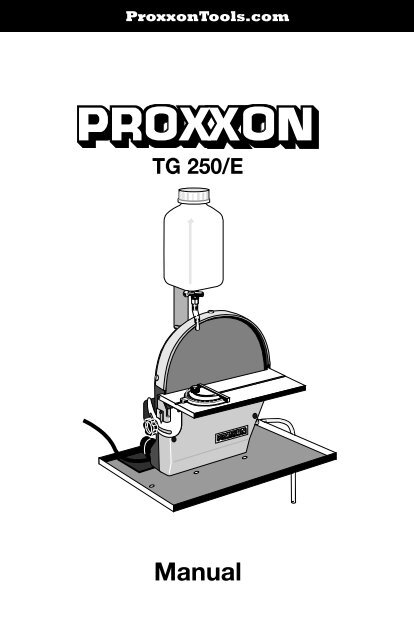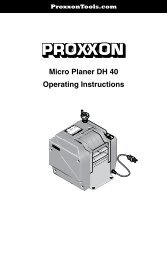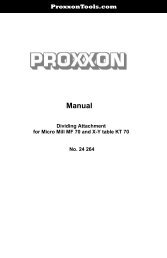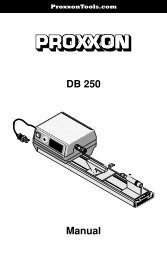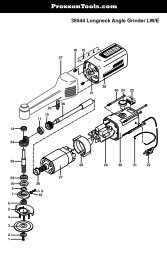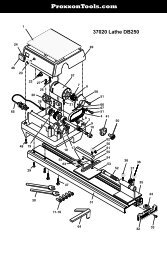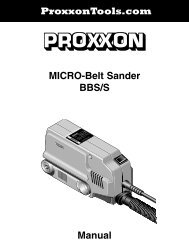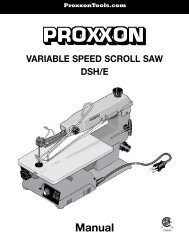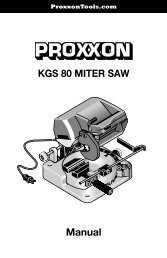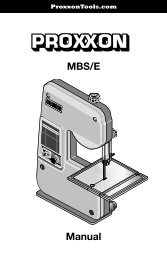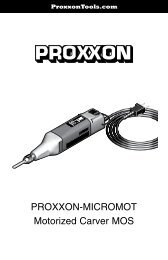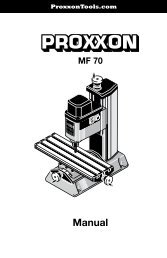Disc Sander TG 250/E Manual - Proxxon Tools
Disc Sander TG 250/E Manual - Proxxon Tools
Disc Sander TG 250/E Manual - Proxxon Tools
Create successful ePaper yourself
Turn your PDF publications into a flip-book with our unique Google optimized e-Paper software.
<strong>Proxxon</strong><strong>Tools</strong>.com<br />
<strong>TG</strong> <strong>250</strong>/E<br />
<strong>Manual</strong>
3<br />
2<br />
6<br />
5<br />
1<br />
1<br />
16<br />
4<br />
2<br />
15<br />
14<br />
13<br />
12<br />
11<br />
10<br />
3<br />
4<br />
5<br />
9<br />
6<br />
8<br />
7<br />
Fig. 1<br />
ø 4,5 mm<br />
10 mm<br />
80 mm<br />
135 mm<br />
Fig. 2<br />
- 2 -
1<br />
2<br />
3<br />
1<br />
Fig. 3<br />
Fig. 4<br />
2 1<br />
Fig. 5<br />
2<br />
90°<br />
1<br />
Fig. 6<br />
- 3 -
Operating Instructions<br />
<strong>Disc</strong> <strong>Sander</strong><br />
Foreword<br />
Dear customer!<br />
The <strong>Proxxon</strong> <strong>TG</strong> <strong>250</strong>/E disk sander is a high-quality tool<br />
for accurate sanding of a wide variety of materials. Please<br />
read the enclosed safety guidelines and operating instructions<br />
to ensure efficient and safe working practices.<br />
This instruction manual covers:<br />
• safety regulations<br />
• operation and maintenance<br />
• spare parts list<br />
Please read carefully!<br />
Using this instruction manual will<br />
• make it easier for you to get used to the machine,<br />
• help prevent faults occurring due to improper use and<br />
• increase the service life of your machine.<br />
Keep this instruction manual in an easily accessible place.<br />
Only operate this machine if you are qualified to do so<br />
and follow the guidelines in this instruction manual.<br />
PROXXON does not accept responsibility for the safe<br />
functioning of the machine<br />
1. if it is handled in a manner which constitutes improper<br />
use,<br />
2. if it is used for other purposes which are not specified<br />
in the instruction manual,<br />
3. if the safety regulations are not observed.<br />
4. Warranty claims are invalid if the machine is incorrectly<br />
operated, or the machine has not been sufficiently<br />
maintained.<br />
In the interests of your safety, please always observe the<br />
safety regulations.<br />
Only use genuine PROXXON spare parts.<br />
We reserve the right to make further alterations for the<br />
purpose of technical progress.<br />
We wish you every success with your machine.<br />
Safety regulations<br />
IMPORTANT<br />
1. Ensure the workplace is tidy.<br />
2. Check the unit for damage before use.<br />
3. (connection cable, protective devices, etc.), have<br />
defective parts replaced by qualified personnel.<br />
4. This unit corresponds to the pertinent safety regulations.<br />
5. Repairs (e.g., replacement of the power supply lead)<br />
may only<br />
6. be performed by a qualified electrician.<br />
7. Never work without the safety equipment fitted.<br />
8. Do not use electrical power tools in the rain, in damp<br />
surroundings or in the vicinity of flammable liquids or<br />
gases.<br />
9. Only use the tool when the handle is dry and free from<br />
grease.<br />
10. Avoid contact with earthed components, e.g., pipes,<br />
radiators, ovens and refrigerators.<br />
11. Protect the connection lead from heat and sharp<br />
edges and<br />
12. route it so it cannot be damaged.<br />
13. Do not remove the plug from the socket by pulling on<br />
the cable.<br />
14. Do not pick up the unit by the cable.<br />
15. Keep children and third parties away from the workplace.<br />
16. Keep tools in childsafe locations when not in use.<br />
17. Do not overload the tool.<br />
18. Do not use the tool to perform operations for which it<br />
is not suitable.<br />
19. Replace blunt tools in good time.<br />
20. Visually inspect application tools to ensure they are in<br />
good working order and suitable for the task prior to<br />
setting up the job.<br />
21. Fasten tools securely.<br />
22. Clean the unit thoroughly following all work.<br />
23. <strong>Disc</strong>onnect the plug from the power supply when the<br />
unit is not in use, before performing maintenance, tool<br />
replacement or repair work.<br />
24. Only plug the unit in when the unit is switched off.<br />
25. Always wear protective goggles (danger of tool breakage).<br />
26. If necessary, wear a protective dust mask.<br />
27. Only use appropriate working clothes (no loose sleeves,<br />
ties, jewellery).<br />
28. Wear a hair net if you have long hair.<br />
29. Only use accessories and spare parts recommended<br />
by PROXXON.<br />
30. Observe the max. permitted rotational speed.<br />
31. If necessary, use dust extract equipment.<br />
32. Do not use the tool when you are tired or under the<br />
influence of alcohol.<br />
33. Keep fingers away from rotating or fast moving tools<br />
(saws, etc.).<br />
34. Keep the operation instructions in a safe place.<br />
- 4 -
General safety instructions<br />
Read and become familiar with this entire instructions<br />
manual. Learn the tool`s applications, limitations and<br />
possible hazards.<br />
1. KEEP GUARDS IN PLACE and in working order.<br />
2. REMOVE ADJUSTING KEYS AND WRENCHES. Form<br />
habit of checking to see that keys and adjusting<br />
wrenches are removed from tool before turning it on.<br />
3. KEEP WORK AREA CLEAN. Cluttered areas and<br />
benches invite accidents.<br />
4. DON'T USE IN DANGEROUS ENVIRONMENT. Don't<br />
use power tools in damp or wet locations, or expose<br />
them to rain. Keep work area well lighted.<br />
5. KEEP CHILDREN AWAY. All visitors should be kept<br />
safe distance from work area.<br />
6. MAKE WORKSHOP KID PROOF with padlocks, master<br />
switches, or by removing starter keys.<br />
7. DON'T FORCE TOOL. It will do the job better and safer<br />
at the rate for which it was designed.<br />
8. USE RIGHT TOOL. Don't force tool or attachment to<br />
do a job for which it was not designed.<br />
9. USE PROPER EXTENSION CORD. Make sure your<br />
extension cord is in good condition. When using an<br />
extension cord, be sure to use one heavy enough to<br />
carry the current your product will draw. An undersized<br />
cord will cause a drop in line voltage resulting in loss of<br />
power and overheating. Table 1 shows the correct size<br />
to use depending on cord length and nameplate<br />
ampere rating. If in doubt, use the next heavier gage.<br />
The smaller the gage number, the heavier the cord.<br />
Exception No. 1: The reference to the table and the<br />
table itself may be omitted if a statement indicating the<br />
appropriate gage and length is incorporated into the<br />
instruction.<br />
Exception No. 2: The information regarding extension<br />
cords need not be provided for a permanently<br />
connected tool.<br />
10. WEAR PROPER APPAREL. Do not wear loose clothing,<br />
gloves, neckties, rings, bracelets, or other jewellery<br />
which may get caught in moving parts. Non-slip<br />
footwear is recommended.<br />
Wear protective hair covering to contain long hair.<br />
Exception: The reference to gloves may be omitted<br />
from the instructions for a grinder.<br />
11. ALWAYS USE SAFETY GLASSES. Also use face or<br />
dust mask if cutting operation is dusty. Everyday<br />
eyeglasses only have impact resistant lenses, they are<br />
NOT safety glasses.<br />
12. SECURE WORK. Use clamps or a vise to hold work<br />
when practical. It's safer than using your hand and it<br />
frees both hands to operate tool.<br />
13. DON'T OVERREACH. Keep proper footing and balance<br />
at all times.<br />
14. MAINTAIN TOOLS WITH CARE. Keep tools sharp and<br />
clean for best and safest performance. Follow<br />
instructions for lubricating and changing accessories.<br />
15. DISCONNECT TOOLS before servicing; when changing<br />
accessories, such as blades, bits, cutters, and the like.<br />
16. REDUCE THE RISK OF UNINTENTIONAL STARTING.<br />
Make sure switch is in off position before plugging in.<br />
17. USE RECOMMENDED ACCESSORIES. Consult the<br />
owner's manual for recommended accessories. The<br />
use of improper accessories may cause risk of injury to<br />
persons.<br />
18. NEVER STAND ON TOOL. Serious injury could occur if<br />
the tool is tipped or if the cutting tool is unintentionally<br />
contacted.<br />
19. CHECK DAMAGED PARTS. Before further use of the<br />
tool, a guard or other part that is damaged should be<br />
carefully checked to determine that it will operate<br />
properly and perform its intended function check for<br />
alignment of moving parts, binding of moving parts,<br />
breakage of parts, mounting, and any other conditions<br />
that may affect its operation. A guard or other part that<br />
is damaged should be properly repaired or replaced.<br />
20. DIRECTION OF FEED. Feed work into a blade or cutter<br />
against the direction of rotation of the blade or cutter<br />
only.<br />
21. NEVER LEAVE TOOL RUNNING UNATTENDED. TURN<br />
POWER OFF. Don't leave tool until it comes to a<br />
complete stop.<br />
Warning<br />
For Your Own Safety Read Instruction <strong>Manual</strong> Before<br />
Operating <strong>Sander</strong><br />
Additional safety instructions for sander:<br />
a) Wear eye protection.<br />
b) Support workpiece on worktable.<br />
c) Maintain 1/16 inch maximum clearance between table<br />
and sanding belt or disc.<br />
d) Avoid kickback by sanding in accordance with the<br />
directional arrows.<br />
GROUNDING INSTRUCTIONS:<br />
1. All grounded, cord-connected tools:<br />
In the event of a malfunction or breakdown, grounding<br />
provides a path of least resistance for electric current to<br />
reduce the risk of electric shock. This tool is equipped with<br />
an electric cord having an equipment-grounding conductor<br />
and a grounding plug.<br />
The plug must be plugged into a matching outlet that is<br />
properly installed and grounded in accordance with all<br />
local codes and ordinances. Do not modify the plug<br />
provided – if it will not fit the outlet, have the proper outlet<br />
installed by a qualified electrician.<br />
Improper connection of the equipment-grounding<br />
conductor can result in a risk of electric shock. The<br />
conductor with insulation having an outer surface that is<br />
green with or without yellow stripes is the equipmentgrounding<br />
conductor. If repair or replacement of the<br />
electric cord or plug is necessary, do not connect the<br />
equipment-grounding conductor to a live terminal. Check<br />
with a qualified electrician or service personnel if the<br />
grounding instructions are not completely understood,<br />
or if in doubt as to whether the tool is properly grounded.<br />
Use only 3-wire extension cords that have 3prong<br />
grounding plugs and 3pole receptacles that accept the<br />
tool's plug.<br />
Repair or replace damaged or worn cord immediately.<br />
- 5 -
2. Grounded, cord-connected tools intended for use on a<br />
supply circuit having a nominal rating less than 150 volts:<br />
This tool is intended for use on a circuit that has an outlet<br />
that looks like the one illustrated in Sketch A in Figure 7.<br />
The tool has a grounding plug that looks like the plug<br />
illustrated in Sketch A in Figure 7. A temporary adapter,<br />
which looks like the adapter illustrated in Sketches B and<br />
C, may be used to connect this plug to a 2-pole receptacle<br />
as shown in Sketch B if a properly grounded outlet is not<br />
available. The temporary adapter should be used only until<br />
a properly grounded outlet can be installed by a qualified<br />
electrician. The green-colored rigid ear, lug, and the like,<br />
extending from the adapter must be connected to a<br />
permanent ground such as a properly grounded outlet box.<br />
Grounding methods<br />
GROUNDING<br />
PIN<br />
<br />
Fig. 7<br />
ADAPTER<br />
<br />
GROUNDING<br />
MEANS<br />
GROUNDING<br />
PIN<br />
Table 1<br />
METAL SCREW<br />
COVER OF GROUNDED<br />
OUTLET BOX<br />
Minimum gage for cord<br />
Effective date for Table 1 changed from November 1, 1995<br />
to November 11, 1996<br />
Ampere Rating Volts Total length of cord in feet<br />
More Not More AWG<br />
Than Than<br />
<br />
<br />
120 V 25 ft. 50 ft. 100 ft. 150 ft.<br />
240 V 50 ft. 100 ft. 200 ft. 300 ft.<br />
0 6 18 16 16 14<br />
6 10 18 16 14 12<br />
10 12 16 16 14 12<br />
12 16 14 12 Not Recommended<br />
Legend (fig, 1)<br />
1. Speed controller<br />
2. On/off switch<br />
3. Working table<br />
4. Angular limit stop clamping bolt<br />
5. Angular limit stop<br />
6. Angular limit stop scale<br />
7. Housing<br />
8. Mains cable<br />
9. Spigots for duct extract unit<br />
10. Clamping bolt for working table adjustment<br />
11. Working table adjustment scale<br />
12. Indicator needle<br />
13. Protective cover<br />
14. Disk sander disk with abrasive disk<br />
15. Spigots for cooling unit<br />
16. Spigots for coolant pipes<br />
Description of the Unit<br />
This disk sander can be used to precisely grind all types of<br />
wood, non-ferrous metals, steel, plastic, cork, rubber and<br />
glass. The stepless speed control permits the grinding<br />
characteristics to be optimally matched to any material.<br />
The working table is manufactured from die-cast aluminium<br />
with a ground surface finish. Self-adhesive abrasive disks<br />
can be readily replaced. The disk sander has dual ballbearing<br />
mounts and the front face of the unit is planeturned.<br />
Warning !<br />
This Disk sander is for indoor use only. Do not expose to<br />
rain or use in damp locations.<br />
Warning !<br />
For your safety, never connect the plug to the power<br />
source receptacle until the assembly and adjustment steps<br />
are completed, and you have read and understood the<br />
safety and operating instructions.<br />
- 6 -
Technical data<br />
Grinding speed:<br />
<strong>250</strong> - 750 m/min<br />
Abrasive disk:<br />
Ø <strong>250</strong> mm<br />
Max. grinding height:<br />
135 mm<br />
Table adjustment:<br />
15° upwards, 45° downwards<br />
Noise level:<br />
72 dB(A)<br />
Vibration: 2.5 m/s 2<br />
Working table:<br />
275 x 105 mm<br />
Overall size:<br />
330 x 280 x 230 mm<br />
Motor:<br />
Voltage:<br />
Power consumption:<br />
Unit Assembly<br />
115 V / 60 Hz<br />
200 Watt<br />
Warning !<br />
To avoid injury from unexpected starting or electrical<br />
shock, do not plug the power cord into a power source<br />
receptacle during unpacking and assembly. This cord must<br />
remain unplugged whenever you are working on the disk<br />
sander.<br />
Warning!<br />
If any part is missing or damaged, do not plug the disk<br />
sander in until the missing or damaged part is replaced,<br />
and assembly is complete. To avoid electrical shock, use<br />
only identical replacement parts when servicing double<br />
insulated tools.<br />
Warning!<br />
Do not attempt to modify this tool or create accessories<br />
not recommended for use with this tool. Any such<br />
alternation or modification is misuse and could result in<br />
hazardous condition leading to possible serious injury.<br />
1. Remove the disk sander from the packaging and check<br />
if any parts are missing.<br />
2. Fasten unit using fastening bolts onto a stable<br />
workbench or working surface, as per fig. 2.<br />
3. Grind a piece of wood and check the angle, if necessary<br />
readjust the working table 3 (fig. 1) and the indicator 12.<br />
Replacing the Abrasive Disk<br />
Warning!<br />
To avoid injury from accidental start, make sure the switch<br />
is in the OFF position and the plug is not connected to the<br />
power source receptacle before changing any parts or<br />
discs.<br />
Remove the abrasive disk<br />
Caution!<br />
<strong>Disc</strong>onnect the mains plug from the power socket.<br />
Warning!<br />
For your own safety, use only abrasive discs sized and<br />
recommended for this disk grinder. Follow the instructions<br />
that accompany the disk grinder.<br />
Note:<br />
The protective cover must be removed when changing the<br />
abrasive disk.<br />
1. Detach the liquid cooling system pipes from the spigots<br />
3 (fig. 3) on the protective cover if present. Release the<br />
fastening bolts 1 and remove the protective cover 2.<br />
2. Detach the abrasive disk from the grinding plate using a<br />
blunt knife or a chisel and remove the abrasive disk<br />
halfway.<br />
The disk can be easily removed from the plate by heating<br />
the adhesive with a hot-air blower.<br />
Important!<br />
Do not damage the grinding plate!<br />
3. Turn the grinding plate approx. 180° and remove the rest<br />
of the disk.<br />
Adjust Angular Indicator<br />
Warning!<br />
For your own safety, do not plug the tool into the power<br />
source receptacle or insert the switch key, until the parts<br />
are correctly installed and adjustments have been made.<br />
1. Slightly release clamping bolt 10 (fig.1) and align the<br />
working table 3 to precisely 90° (using a square) (fig. 6).<br />
Retighten the clamping bolt.<br />
2. Check and if necessary correct the zero setting of the<br />
indicator 12 (fig. 1), after releasing the clamping bolts.<br />
Note:<br />
Perform a grinding test before performing precision work.<br />
Attaching New Sheet of Abrasive Material<br />
Note:<br />
Thoroughly clean the grinding plate before applying the<br />
new abrasive disk.<br />
Warning!<br />
Use only accessories recommended for this disk sander.<br />
Follow the instructions that accompany accessories. Use<br />
of improper accessories may cause hazards.<br />
1. Pull off half of the protective foil for the new abrasive<br />
disk.<br />
2. Insert the abrasive disk halves with the protective foil<br />
between the working table and the grinding plate (fig. 4).<br />
- 7 -
Note:<br />
When applying the abrasive disk on the grinding plate,<br />
start from the centre and work outwards.<br />
3. Apply the top half of the abrasive disk on the grinding<br />
plate precisely in the correct position.<br />
4. Rotate the grinding plate approx. 180°, remove the<br />
second half or the protective foil and use the same<br />
procedure to apply the disk.<br />
5. Reattach the protective cover.<br />
Working with the Disk sander<br />
Important!<br />
Safe and precision working practice can only be ensured<br />
with the unit properly secured!<br />
Do not leave the unit switched on if unsupervised.<br />
1. Switch on the disk sander.<br />
2. Adjust the rotational speed of the disk sander using the<br />
speed controller 1 (fig. 1).<br />
3. Place the work piece on the working table, guide it<br />
gently and carefully.<br />
4. Always exert pressure on the working table rather than<br />
against the abrasive disk.<br />
Note:<br />
Please note the following items in order to ensure good<br />
grinding results:<br />
1. Do not overload the unit (if the fuse blows, only use an<br />
original fuse (1.25 T) as a replacement)!<br />
2. The disk sander is primarily designed for grinding<br />
precise angles. The more accurately the work piece is<br />
pre-cut, the quicker and easier it will be to produce<br />
precise angles and the less abrasive disks will be<br />
required to perform the task.<br />
3. Please note the dissimilar grinding speeds for the<br />
abrasive disk (fig. 6):<br />
inner diameter = low speed<br />
outer diameter= high speed<br />
4. The abrasive disk turns in an anti-clockwise direction.<br />
For this reason, only grind on the left half of the working<br />
table.<br />
With horizontally set working table<br />
1. Release the clamping bolt 2 (fig. 6) and set the working<br />
table horizontally (indicator at "0").<br />
2. Tighten clamping bolt 2.<br />
3. Set the angular limit stop 1 (fig. 6) to the desired angle<br />
(e.g., 45°).<br />
Liquid Cooling System<br />
We recommend that the liquid cooling system is attached<br />
when grinding iron, steel and non-ferrous metals, as well<br />
as stone, tiles, ceramics (not included in scope of supply,<br />
available as an accessory).<br />
The heat arising from grinding operations is dissipated by<br />
supplying coolant, thus improving the resulting surface<br />
quality.<br />
Dust Extract Connection<br />
In order to permit a dust-free working environment, the<br />
disk sander is equipped with a vacuum cleaner connection<br />
for dust extraction.<br />
Important!<br />
When using both a vacuum cleaner (as a dust extract unit)<br />
and the liquid cooling unit, ensure that the vacuum cleaner<br />
is suitable for aqua cleaning as well.<br />
1. Connect the vacuum cleaner hose to the connection<br />
spigot 9 (fig. 1).<br />
2. Switch on the vacuum cleaner.<br />
3. Switch on the disk sander, grind the work piece.<br />
Important!<br />
Only use abrasive disks which are in a flawless<br />
condition. Replace worn abrasive disks promptly.<br />
Grinding a Mitre with the Working Table Inclined<br />
1. Release the clamping bolt 2 (fig. 5) and set the working<br />
table to the desired angle (e.g., 45°).<br />
2. Tighten clamping bolt 2.<br />
3. Set angular limit stop 1 (fig. 5) to position "0"<br />
- 8 -
Cleaning and Care<br />
Your disk sander was developed for minimal maintenance,<br />
however regular cleaning is required to ensure a long<br />
trouble-free service life.<br />
Caution!<br />
Always disconnect the mains plug prior to cleaning and<br />
maintenance operations.<br />
1. Regularly inspect the mains cable for damage.<br />
2. Ensure the abrasive disk is securely seated and in<br />
perfect condition, if necessary replace the abrasive disk.<br />
3. Thoroughly clean the disk sander after use.<br />
Warning!<br />
To avoid fire or toxic reaction, never use gasoline, naphtha,<br />
acetone, lacquer thinner, or similar highly volatile solvents<br />
to clean the disk sander.<br />
Do not allow brake fluids, gasoline, or penetrating oils to<br />
come in contact with the plastic parts. They contain<br />
chemicals that can damage or destroy plastics.<br />
Turn switch OFF and always remove plug from power<br />
source before making any adjustments or repairs.<br />
All electrical or mechanical repairs should be done only by<br />
qualified service technicians.<br />
When servicing use only PROXXON replacement parts.<br />
Use of any other parts may create a hazard or cause<br />
product damage.<br />
Any attempt to repair or replace electrical parts on this disk<br />
sander may create a hazard unless repair is done by a<br />
qualified service technician. Repair service is available at<br />
your PROXXON service center (You find the address at<br />
address at the back of this manual)<br />
- 9 -


